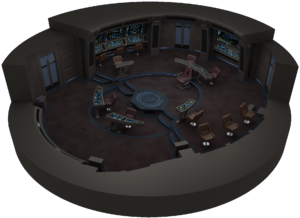USS Melbourne
More actions
USS Melbourne NCC-71944 is a Nebula-class Federation starship currently assigned to the Fourth Fleet's Task Force 17 under the command of Captain Elara Quinn.
Melbourne has become something of a workhorse in recent years as she takes on a variety of mission profiles across Federation space and beyond. Even as the Nebula-class ceases production after forty-years of reliable service, the ship's versatile mission pod adds to her impressive mission capabilities, making her an integral asset in Task Force 17’s mission of deep space operations.
Only the second vessel to proudly bear the name throughout Starfleet’s illustrious history, Melbourne was launched in late 2372, a successor to her Excelsior-class predecessor. With decommissioning looming at the end of 2402, Captain Elara Quinn and her crew set forth on their final mission to push the boundaries of scientific understanding and to explore strange new frontiers.
Design and Layout
Modelled on the successful layout of older, larger vessels such as the Sovereign-class, the Melbourne bridge has a slightly altered colour scheme and a much-changed console layout across the bridge. Making the most of a variety of technological advancements, such as holoprojectors, holographic communications, in-built weapons lockers and three-dimensional computer displays in places. Perhaps one of its most charming features is the emblem of the United Federation of Planets emblazoned on the carpeting as a constant reminder of all the ship stands for.

In a move away from more recent styles, and harking back to the traditional layouts of yesteryear, Melbourne has a single center command seat for the commanding officer allowing the occupant full view of all stations. Directly ahead of them, down a few steps and between the commanding officer and the holographic viewscreen, two angled consoles serve as duty stations for Operations (port) and Flight Operations (starboard). Next, and facing into the heart of the bridge to allow maximum participation with the rest of the bridge crew are duty stations for science (port) and tactical operations (starboard). Directly behind the commanding officer, and in a further break from tradition, a combined duty station serves as positioning for the two most senior advisors and assistants to the ship's commander; the Executive Officer (starboard) and, when appropriate, the mission advisor or specialist (port). Around the outside of the bridge, there are countless other additional stations. Behind the main science station on the port bulkhead, additional science and medical consoles are available for mission operations, as well as access to life support and environmental controls. Adjacent to them on the starboard bulkhead, mission operations and security stations ensure the continued safety of the ship and crew on a day-to-day, mission-by-mission basis. On the aft bulkhead, engineering is the focus. With a large, entirely interactive and customizable master systems display (MSD) and other engineering controls, the representative from engineering has full access to the ship's systems.
Around the command center, four doors provide access to and from the bridge. On the forward port bulkhead, access is available to the observation lounge, whilst the starboard door grants access to the commanding officer's private ready room (available for use by any officer in command of the ship). At the aft of the bridge, both doors provide access to turbo lifts which enable the crew to access the command center from the rest of the bridge. The starboard turbo lift grants express, overridden access to key locations such as engineering, shuttlebay 1, sickbay, tactical astrometrics and transporter rooms 1 and 2.
